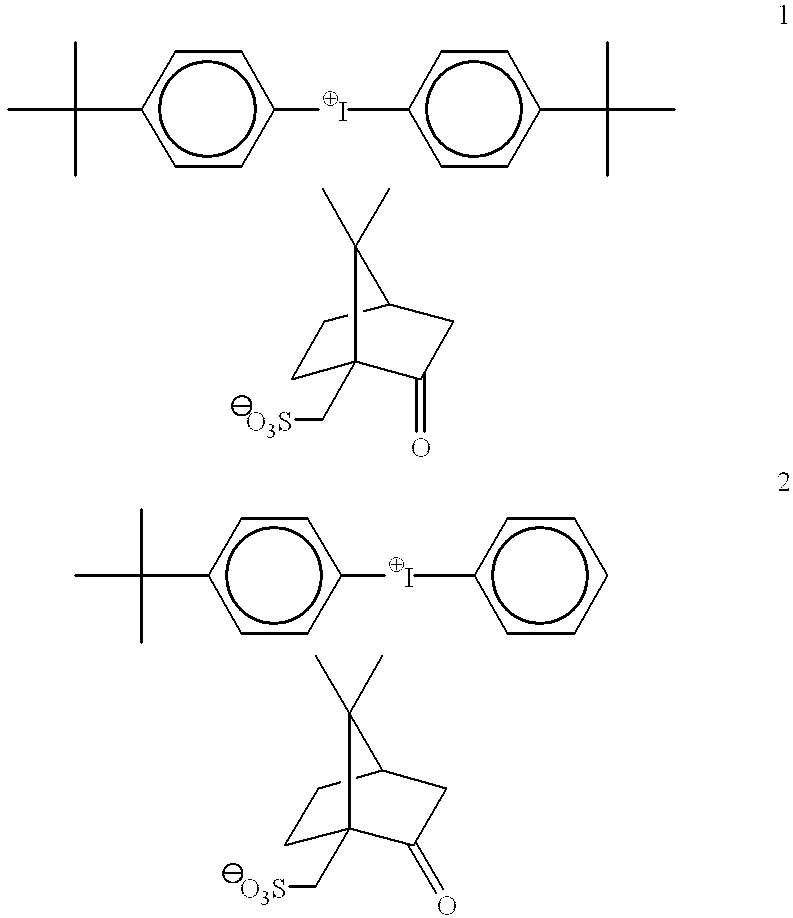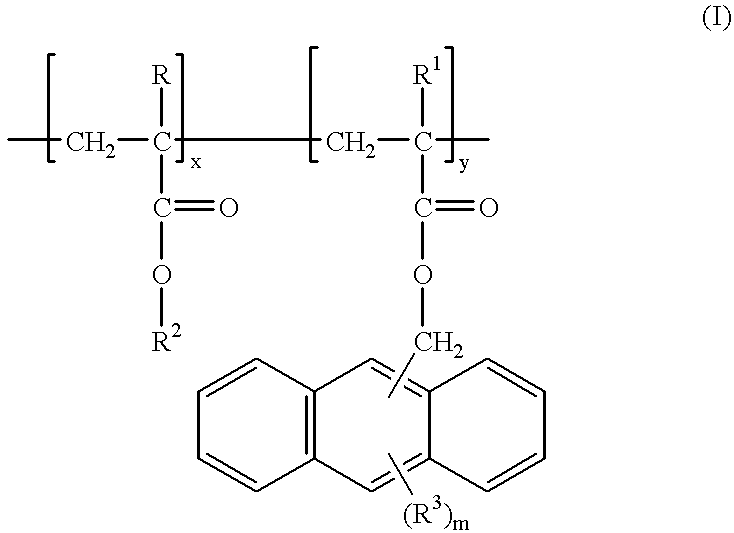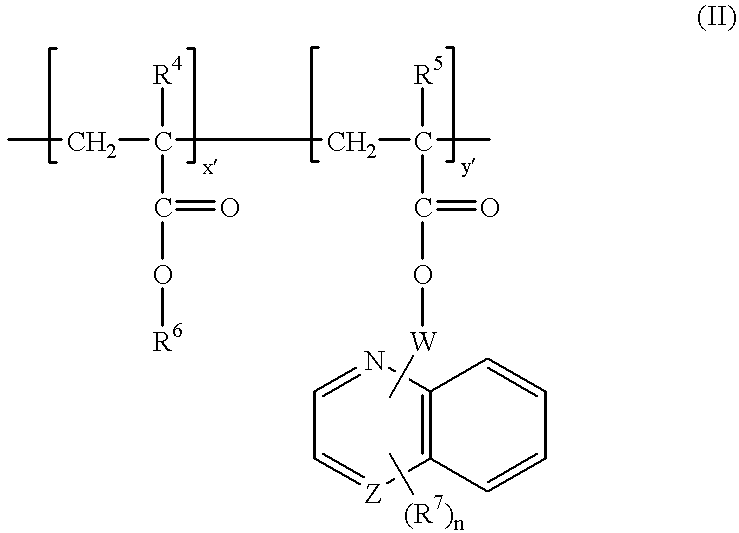Antireflective coating compositions comprising photoacid generators
a technology of photoacid generators and compositions, applied in the direction of plastic/resin/waxes insulators, photosensitive materials, instruments, etc., can solve the problems of acid loss, acid neutralization of photoacid generators of chemically amplified resists, and affecting the resolution of the resist layer, so as to reduce undesired notching and footing
- Summary
- Abstract
- Description
- Claims
- Application Information
AI Technical Summary
Benefits of technology
Problems solved by technology
Method used
Image
Examples
example 1
Preparation of Preferred Antireflective Composition Resin Binders
Hydroxyethyl methacrylate (HEMA) / methylanthracene methacrylate (ANTMA) copolymer (Formula I above) was prepared as follows.
A 300 ml 3N round bottom flask equipped with magnetic stirrer, condenser, nitrogen and vacuum inlet was charged with 16.0 g (0.1229 mol) HEMA (purified by distillation), 8.49 g (0.0307 mol) methylanthracene methacrylate, 0.2449 g (1 wt %) AlBN and 180 ml THF. The reaction flask was quenched in liquid nitrogen while being purged with nitrogen. When the contents of the reaction flask were frozen, the flask was evacuated, then purged with nitrogen (3 times). The reaction mixture was stirred under reflux for 18 hours. The pale yellow polymer was precipitated into 3000 ml ether, filtered, then dried at 50° C. under vacuum (yield 86%) to provide the HEMA / ANTMA copolymer having 81 mole percent of —CH2C(CH3)(CO2CH2CH2OH)— units and 19 mole percent of —CH2C(CH3)(CO2CH2—9-anthracene) units, a Mn of 2295, Mw ...
example 2
Preparation of Di(4-t-butyphenyl)iodonium(+ / −)-10-Camphor Sulfonate
The PAG 1 above can be prepared as follows. A 2 L 3 neck round bottom flask was charged with potassium iodate (214.00 g, 1.00 mol), t-butylbenzene (268.44 g, 2.00 mol) and acetic anhydride (408.36 g, 4.00 mol). The flask was fitted with an efficient overhead paddle stirrer, a thermometer and a pressure equalizing dropping funnel fitted with a N2 bubbler. The reaction mixture was cooled to 10° C. in a ice-water bath and concentrated sulfuric acid (215.78 g, 2.20 mol) added dropwise via the addition funnel. The addition was carried out at such a rate as to maintain the reaction temperature around 25° C. and required 2 hours. As the addition proceeded the starting white suspension became orange-yellow in color. Once the addition was over, the reaction mixture was stirred at room temperature (20° C.) for an additional 22 hours. The reaction mixture was cooled to 5-10° C. and water (600 ml) was added dropwise over a perio...
example 3
A preferred antireflective composition of the invention was prepared by mixing the components set forth below, with component amounts expressed as parts by weight based on total weight of the liquid antireflective coating composition:1) Resin binder: 2.17% Polymer (novolac resin base with approximately 4% glycidyl groups replacing OH, and approximately 80% of OH groups replaced by —O(C═O)CH29-anthracene)2) Crosslinker: 0.61% Powderlink 1174 (American Cyanamid)3) Acid: 0.06% p-toluene sulfonic acid4) Photoacid generator: 0.16% di-t-butyl diphenyl iodonium camphorsulfonate5) Surfactant: 0.03% FC 171 (3M Co.)6) Solvent: 18% ethyl lactate; 10% cyclohexanone; and 68.97% propylene glycol monomethyl ether
The antireflective composition was spin coated onto a single crystal silicon substrate 100 mm in diameter, and baked on a vacuum hot plate at 175° C. for 60 seconds. The resulting thickness was 600 angstroms. Over this antireflective composition layer a commercially available DUV positive ...
PUM
| Property | Measurement | Unit |
|---|---|---|
| Temperature | aaaaa | aaaaa |
| Antireflective | aaaaa | aaaaa |
Abstract
Description
Claims
Application Information
 Login to View More
Login to View More - R&D
- Intellectual Property
- Life Sciences
- Materials
- Tech Scout
- Unparalleled Data Quality
- Higher Quality Content
- 60% Fewer Hallucinations
Browse by: Latest US Patents, China's latest patents, Technical Efficacy Thesaurus, Application Domain, Technology Topic, Popular Technical Reports.
© 2025 PatSnap. All rights reserved.Legal|Privacy policy|Modern Slavery Act Transparency Statement|Sitemap|About US| Contact US: help@patsnap.com



